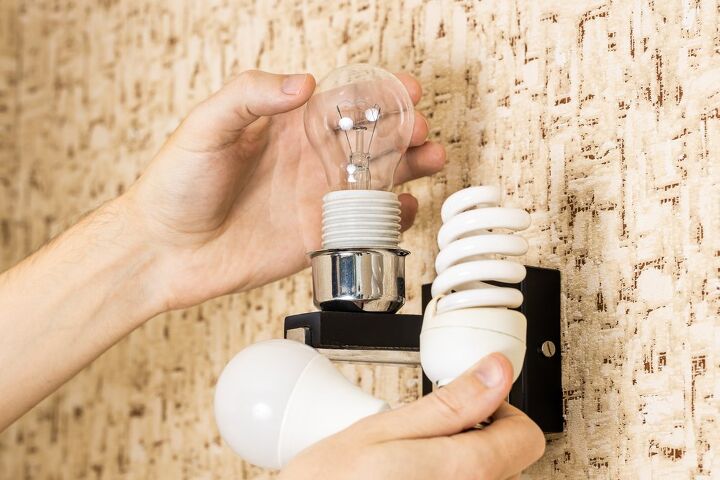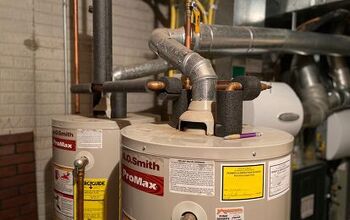Can You Put A 3-Way Bulb In Any Lamp? (Find Out Now!)

You sit down for an enjoyable evening reading only to discover that the bulb in your reading lamp is burned out. You find that the only extra bulb you have is a 3-way bulb. Rather than make a special trip to the store, you wonder if you can put a 3-way bulb in the lamp.
You can put a 3-way bulb into a standard lamp without problems. The three-way bulb has three electrical contacts. When a 3-way bulb is put into a standard lamp socket, the bulb will operate at medium power. On most 3-way bulbs, the medium power will produce the same amount of light as a standard 100 watt light bulb.
You won’t damage the bulb or the lamp by putting a 3-way lightbulb in a standard socket. However, 3-way lightbulbs are more expensive than standard light bulbs. Using a 3-way bulb in a standard socket is not very economical or efficient.
How Do 3-Way Light Bulbs Work?
3-way incandescent light bulbs have two separate filaments inside the bulb. Different combinations of filaments can produce three different levels of light. The typical 3-way incandescent lightbulb produces light like a 50, 100, or 150 W lightbulb.
A standard incandescent light bulb has two contacts, one of which is located on the bottom center of the bulb. A 3-way bulb has three separate contacts, two of which are on the bottom of the bulb. The two bottom contacts on a 3-0way lightbulb engage with special contacts in the 3-way socket. This allows you to choose between one of three power settings.
One of the filaments in the light bulb produces 50 watts of light. The other filament produces 100 watts of light. When both filaments are used, the lightbulb produces 150 watts of light. This makes a three-way lamp convenient where differing light levels are wanted without having many different laps or fixtures.
Can I Use a Standard Light Bulb in a 3-Way Lamp?
You can operate a standard light bulb in a 3-way lamp. The light bulb will operate normally when the 3-way lamp is turned to the medium or high setting. In general, the standard light bulb won’t work if the lap is set to the low switch setting. You won’t damage the bulb or the lamp by using a standard bulb in a 3-way lamp socket.
Can LED Bulbs be Used in 3-Way Lamps?
LED bulbs can be used in both standard and 3-way lamps. 3-Way LED lamps to operate much like incandescent 3-way light bulbs. Instead of filaments, 3-way LED light bulbs turn on extra LEDs to increase the light. In most cases, the base of the LED lightbulb looks exactly like the base of a standard 3-way incandescent bulb.
You can put most standard LED light bulbs in a three-way socket. Like an incandescent bulb, the LED bulb will only work when the 3-way socket switch is on the medium or high setting.
Can you Upgrade a Standard Lamp Socket to a 3-Way Socket?
Sometimes you find the need for different lighting levels from a lamp that only has only a standard socket. Rather than buy a new lamp, it may be more practical to change the socket to a 3-way socket than to find another lamp that fits your décor.
Changing out a standard socket for a 3-way socket is an economical alternative. Making the change is not difficult and can often be performed in just a few minutes. Turning your lamp into a 3-way configuration can add versatility and new life to your lamp.
Step 1: Getting Ready to Make the Change?
Before you start to make the chance-over from a standard socket to a 3-way light socket, you should gather your tools and parts. To make the change, you should have on hand:
- A new 3-way socket to replace the standard socket. These are easily found at most home improvements stores for about $5.
- A 3-way bulb
- One standard Philips screwdriver
When you are choosing your lightbulbs, we recommend that you opt for an LED 3-way lightbulb. The upfront cost of an LED 3-way bulb is a little more than a standard incandescent bulb but can last up to 25 times longer. This longer life more than offsets the additional up-front cost.
Step 2: Work Safe
Before working on your lamp, make sure the lamp cord is unplugged from the electrical outlet. Never work on an electrical appliance when it is plugged in, or the electricity to the circuit is turned on.
Step 3: Remove the Lamp Shade and the Harp
Lampshades attach to the harp at the top of the harp with a threaded nut. Unscrew the nut and lift the shade off the lamp.
The harp attaches to the lamp near the base of the socket. Typically, the harp can be squeezed inward to release it from the base and lay the harp aside.
Step 4: Remove the Socket and expose the Wire Connections
Remove the outer shell of the socket and the insulating sleeve. Most of these sockets are removed by squeezing the shell and lifting upwards. Pull the socket upwards until you expose the wires.
Step 5: Unscrew the Wires from the Socket
Use your Phillips screwdriver to remove the wires from the socket. Make a note of where each wire is connected. It is usual for the wire with a rib or marking to be connected to a silver screw. The polarity needs to be correct on your electrical circuit.
Step 6: Install the New 3-Way Socket
Reverse the steps above to install your new 3-way socket. Make sure the wires go back to the proper screw. It is usual for the ribbed wire or a wire with a marking attached to the silver screw.
Don’t forget to install the plastic or cardboard insulating sleeve back into the socket. Screw in the new 3-way lightbulb, replace the harp and the shade. Your newly upgraded lamp is ready to enjoy.
3-Way Bulbs in Standard Sockets
It is possible to use a 3-way bulb in a standard socket. It will work but isn’t the most economical use of resources. It would be better if the type of bulb matched the type of socket. We recommend that as you replace your incandescent bulbs, you use LED bulbs to conserve energy.

Dennis is a retired firefighter with an extensive background in construction, home improvement, and remodeling. He worked in the trades part-time while serving as an active firefighter. On his retirement, he started a remodeling and home repair business, which he ran for several years.
More by Dennis Howard



























